Also referred to, at least around here, as “Girlled Cheese Sandwiches”. It makes about as much sense; after all, I don’t cook them on a grill (I use a griddle), and, at least around here, they’re always made by girls.
Once upon a time, I got a subscription to Cook’s Illustrated. I think I was in my mid-teens. Anyway, I heard it was supposed to be a very technical magazine, which was why I was interested in it. (I’m one of those people who was utterly fascinated by getting chef textbooks out of the library, those books where they show you the proper way to use a knife and cut an onion.) I was utterly disappointed by the magazine. My memory says it was short on illustrations, 97% opinion, 2% keeping your eyes open while you worked and experimenting, and 1% technique. Well, thank you very much, I already had plenty of opinions, and didn’t see the need to pay that much for them. As for experimenting and keeping your eyes open, yes, it could be handy to have that work done for you already, as long as they were writing on a topic that was actually relevant to you. But, in that case, you’d usually already figured most of it out yourself.
The straw that broke the camel’s back was when they ran an article on the “best” way to make a grilled cheese sandwich, as though that was a great mystery. I’ve been making grilled cheese sandwiches for nearly as long as I can remember, and all the “wrong” ways were so absurd I’d never even tried making them that way. I read the article, thought “Duh! I’ve know all of this since I was 9 years old,” and canceled my subscription. I figured they ought to be handing out more insight than 9 year old, if they expected me to actually pay for it.
But, just in case they were right, and people really do want to be shown how to make grilled cheese sandwiches, I thought I’d do it properly. (But I didn’t just “discover” this method, and I make no claims it’s the “best” way. It’s just my version of common sense and good taste.)
To make sandwiches, you first have to start with the bread. You can use anything you have laying around, like this:
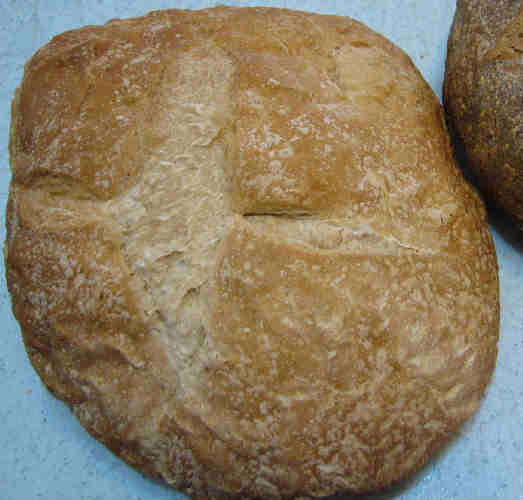
I made that bread a week ago, when cooking marinaded chicken. The bread used a starter, and long, cool raises, and then was baked on stones. I was quite impressed it hadn’t begun to mold or sour, and was only just beginning to dry out. I also used some loaf-bread I had made, ’cause this one loaf wasn’t enough. (I need to make three griddle fulls before everyone’s properly fed. This loaf made one griddle full.)
It should go with out saying that the better quality bread you use, the better your sandwich will be. Don’t think you can use some putty-like saw dust bread and get a good sandwich. Good bread makes good sandwiches, and bad bread makes bad sandwiches.
Slice your bread, assuming it isn’t a pre-sliced bread.
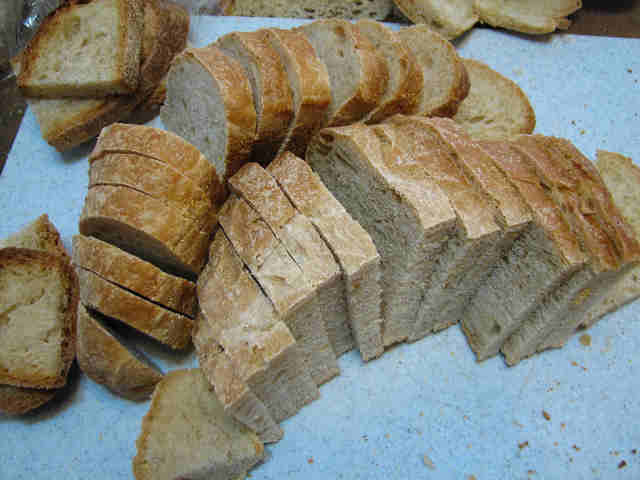
Arrange your bread in sandwiches on your griddle.
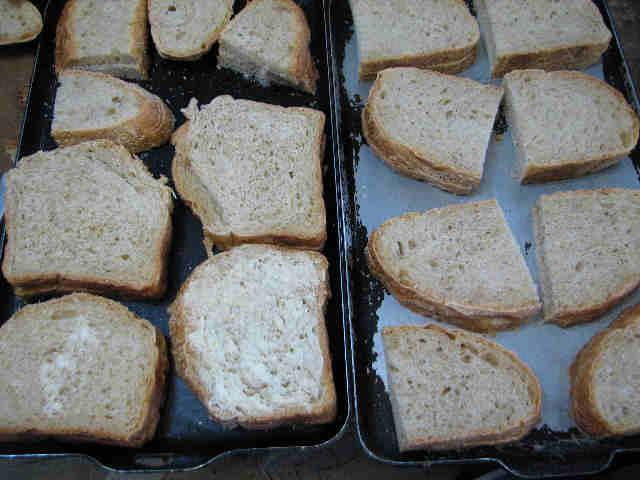
A good griddle is a thick griddle. They’re hard to find now; if you’ve still got your grandmother’s griddle, hang on to it. And don’t get suckered by claims of “non-stick”–I’ve yet to see a non-stick coating that didn’t come off the pan easier than the food came off the coating.
Butter your bread, every slice, the outside face only.

Use soft butter, or you’ll tear your bread. Anywhere the butter doesn’t touch won’t brown, but you don’t want to put the butter on too thick or you’ll wind up with a soggy, greasy sandwich.
Grate your cheese.
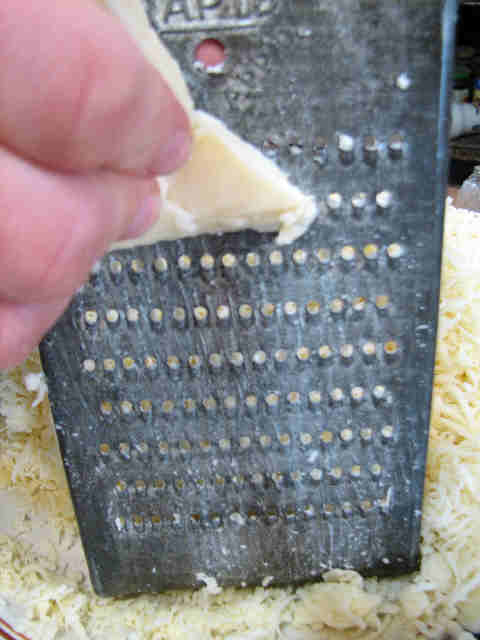
I got a minion to do this for me, so those aren’t my hands, in case you’re deathly curious.
I’m using swiss cheese, and a fine grater. The grater used to belong to a great-grandmother of mine, and they don’t make graters as sharp as they used to anymore. The finer you grate it, the easier it is to distribute evenly. Don’t go thinking you can just take out one of those plastic, square shaped slices and call it evenly distributed cheese–that stuff is pushing the boundaries of “edible”, and we’re talking about making food here. You can use any cheese you want, but it’s the same deal as the bread–the better the ingredients, the better the final product. If you don’t have to keep whacking people for trying to eat up all your cheese before you get it in the sandwiches and melted, you aren’t using good enough cheese.
Next, you add the cheese and seasonings to the bread.
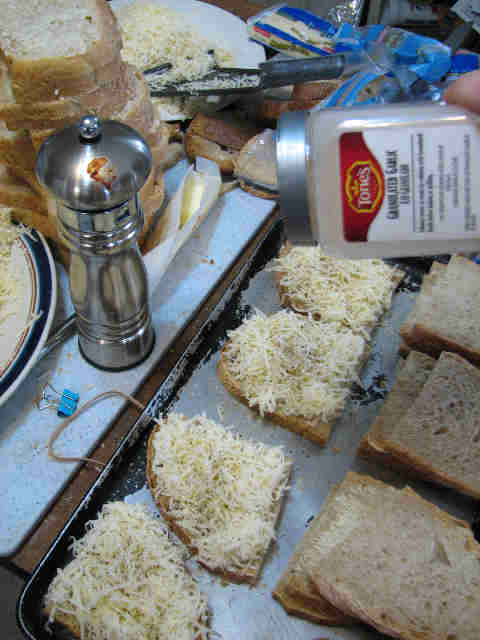
I’m using coarse ground black pepper and garlic powder. If you use muenster or mozzarella cheese, basil and oregano go great. Fresh rosemary would probably be good, too, but dried stuff is miserable. I used about 2 lbs. of cheese for 3 griddles of sandwiches. I open up half the sandwiches, put on the cheese and seasonings, and then close the sandwiches. Then I do the same for the second half. Arranging things on the griddle is really only important because I’m using homemade bread, which is slightly irregular, and you need to see how things fit together. If you were using very regular bread, you can just butter all the bread, lay down one layer, put on the cheese and seasonings, and then lay down the second layer.
Pop them on the stove, and turn on the heat.
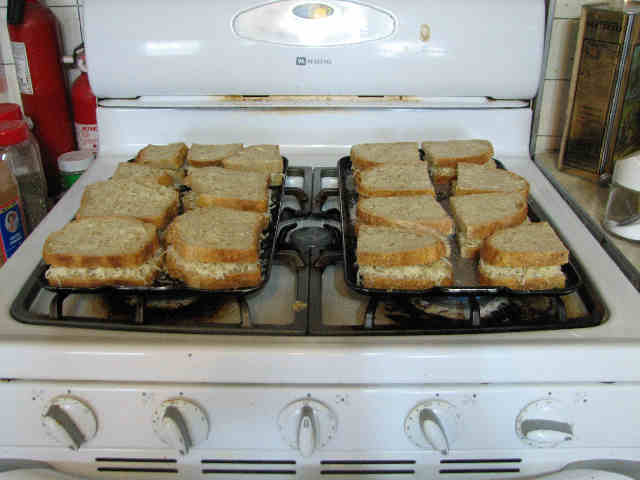
The heat needs to be at “medium”. With my old gas stove that had all the markings wore off, this meant until the flame burned straight up, with no curve, and was pure blue, with no streaks of orange. With my new gas stove, that means “medium” on the back burners, “low” on my hottest burner, and “medium low” on my medium burner. The flame matches the description of my old stove, so I think that must be a pretty accurate description of the temperature. But the point of the heat is get the sandwich to cook right–too hot, and it will burn around the edges, and maybe even cook the bread before the cheese melts. Too cool, and your bread will get soggy from melted butter, and the cheese will start melting out of the sandwich before the bread burns.
Check to see if they need to be flipped.
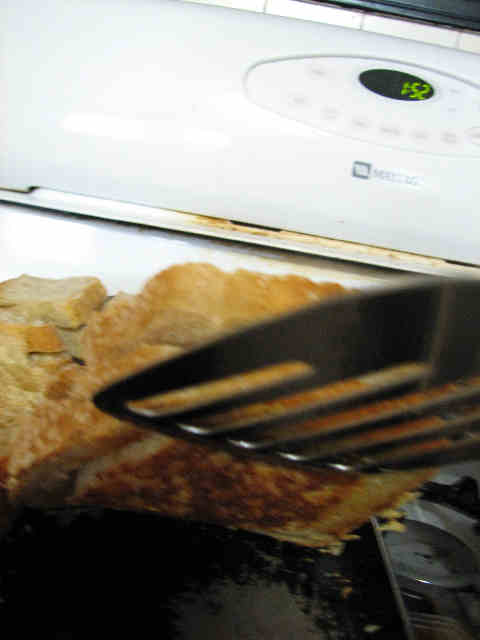
This is accomplished by sticking your spatula under a sandwich, and lifting it up for a peek. For best cooking, a sandwich should only be flipped once, so wait until the underside is dark golden brown before you flip anything. Once that side is fully cooked, you can flip everything over.
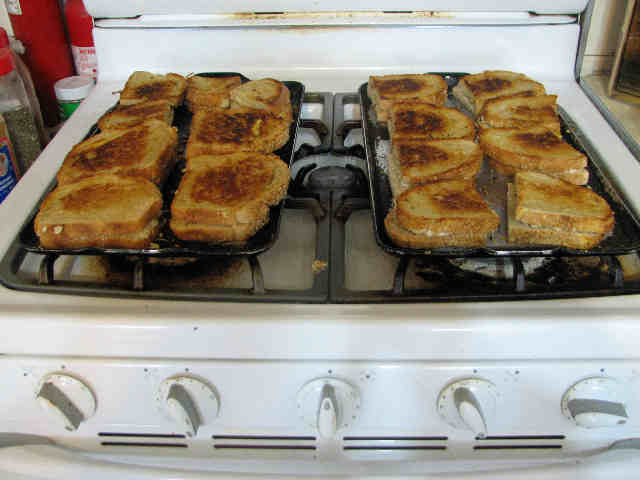
Look good, don’t they? Now you just need to wait until the second side cooks, but since the griddle has had plenty of time to get hot, it will be a much shorter wait. If you don’t keep an eye on them, they’ll burn.
Then they’re done, and ready to eat!

Since grilled cheese sandwiches are by nature high in fat content, it’s best if you can eat something a little acidic with it. I had a tangerine, but I bet the muenster/mozzarella sandwiches would be great dipped into a good tomato sauce.
Posted in Recipes | 1 Comment »
April 14th, 2008 at 2:17 pm
i did not like this site because you made the grilled cheese look NASTY!!